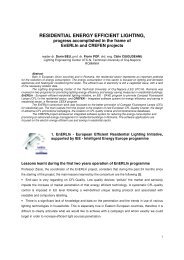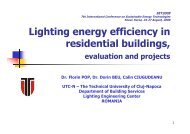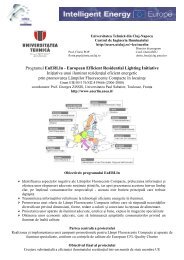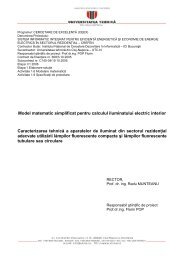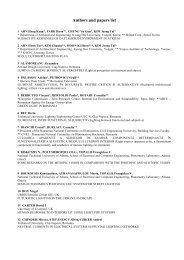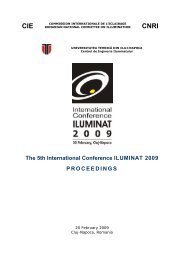Energy Efficient Railway Lighting according to EN 12464-2 „Lighting ...
Energy Efficient Railway Lighting according to EN 12464-2 „Lighting ...
Energy Efficient Railway Lighting according to EN 12464-2 „Lighting ...
You also want an ePaper? Increase the reach of your titles
YUMPU automatically turns print PDFs into web optimized ePapers that Google loves.
<strong>Energy</strong> <strong>Efficient</strong> <strong>Railway</strong> <strong>Lighting</strong><br />
<strong>according</strong> <strong>to</strong> <strong>EN</strong> <strong>12464</strong>-2<br />
„<strong>Lighting</strong> of work places – Part 2:<br />
Outdoor work places“<br />
Dipl.-Ing. Axel S<strong>to</strong>ckmar<br />
Honorary Professor, Hanover University of Applied Sciences and Arts<br />
LCI Light Consult International, Celle, Germany<br />
A. S<strong>to</strong>ckmar ILUMINAT 2009, Cluj-Napoca 1
Standardisation Bodies and <strong>Lighting</strong> Societies<br />
ISO CIE<br />
C<strong>EN</strong><br />
AFNOR<br />
BSI<br />
DIN<br />
LUX<br />
EUROPA<br />
AFE<br />
SLL<br />
LiTG<br />
A. S<strong>to</strong>ckmar ILUMINAT 2009, Cluj-Napoca 2
The current seven CIE Divisions (2009)<br />
• Div. I Vision & Colour<br />
• Div. II Physical Measurement of Light and<br />
Radiation<br />
• Div. III Interior Environment and <strong>Lighting</strong><br />
Design<br />
• Div. IV <strong>Lighting</strong> and Signalling for Transport<br />
• Div. V Exterior and other <strong>Lighting</strong><br />
Applications<br />
• Div. VI Pho<strong>to</strong>-biology and Pho<strong>to</strong>-chemistry<br />
• Div. VIII Image Technology<br />
A. S<strong>to</strong>ckmar ILUMINAT 2009, Cluj-Napoca 3
C<strong>EN</strong> TC 169 Light and <strong>Lighting</strong> (2009)<br />
• WG1 Basic Terms and Criteria (<strong>EN</strong> 12665)<br />
• WG2 <strong>Lighting</strong> of Work Places (<strong>EN</strong> <strong>12464</strong>-1/2,<br />
<strong>EN</strong> 13032-2)<br />
• WG3 Emergency <strong>Lighting</strong> (<strong>EN</strong> 1838, <strong>EN</strong> 13032-3)<br />
• WG4 Sports <strong>Lighting</strong> (<strong>EN</strong> 12193)<br />
• WG5 Road <strong>Lighting</strong> (<strong>EN</strong> 13201)<br />
• WG6 Tunnel <strong>Lighting</strong> (CR 14380)<br />
• WG7 Pho<strong>to</strong>metry (<strong>EN</strong> 13032-1)<br />
• WG8 Pho<strong>to</strong>biology (<strong>EN</strong> 14255)<br />
• WG9 <strong>Energy</strong> Performance of Buildings –<br />
<strong>Energy</strong> Requirements for <strong>Lighting</strong> (<strong>EN</strong> 15193)<br />
• WG10 Performance of Optical Material for Luminaires<br />
A. S<strong>to</strong>ckmar ILUMINAT 2009, Cluj-Napoca 4
Relevant CIE Publications for <strong>EN</strong> <strong>12464</strong>-2<br />
• CIE 112-1994 Glare Evaluation System for Use<br />
within Outdoor Sports and Area <strong>Lighting</strong><br />
• CIE 115-1995 Recommendations for the <strong>Lighting</strong><br />
of Roads for Mo<strong>to</strong>r and Pedestrian Traffic<br />
• CIE 129-1998 Guide for <strong>Lighting</strong> Exterior Work<br />
Places<br />
• CIE 140-2000 Road <strong>Lighting</strong> Calculations<br />
• CIE 150-2003 Guide on the Limitations of the<br />
Effects of Obtrusive Light from Outdoor <strong>Lighting</strong><br />
Installations<br />
• CIE 154-2003 Maintenance of Outdoor <strong>Lighting</strong><br />
Systems<br />
A. S<strong>to</strong>ckmar ILUMINAT 2009, Cluj-Napoca 5
Other Relevant Publication for <strong>EN</strong> <strong>12464</strong>-2<br />
• A.F.E. „Recommandations relatives à<br />
l´éclairage des voies publiques“<br />
• CIBSE LG6 „The Outdoor Environment”<br />
• DIN 5035 „Beleuchtung mit künstlichem Licht“<br />
• ICAO „International Standards and<br />
Recommended Practices Aerodromes”<br />
• DB 954.9103 „Beleuchtungsanlagen im<br />
gleisnahen und/oder sicherheitsrelevanten<br />
Bereich“<br />
etc.<br />
A. S<strong>to</strong>ckmar ILUMINAT 2009, Cluj-Napoca 6
<strong>Lighting</strong> Design Criteria (<strong>EN</strong> <strong>12464</strong>-2)<br />
• Luminance distribution (description only)<br />
• Illuminance levels (maintained values),<br />
uniformities, and diversities<br />
(for task areas and surroundings)<br />
• Limitation of glare<br />
(for train drivers and passengers)<br />
• Directionality of light (description only)<br />
• Colour appearance and colour rendering<br />
• Avoidance of flicker and stroboscopic effects<br />
(description only)<br />
• Limitation of obtrusive light<br />
A. S<strong>to</strong>ckmar ILUMINAT 2009, Cluj-Napoca 7
Illuminances, <strong>EN</strong> <strong>12464</strong>-2 (I)<br />
• All values of illuminances in this standard are<br />
maintained illuminances over the task area<br />
on the reference surface which may be<br />
horizontal, vertical or inclined.<br />
• The task area is defined as the partial area in<br />
the work place in which the visual task is<br />
carried out.<br />
• For places where size and/or location of the<br />
task area are unknown, the area where the<br />
task may occur is the task area.<br />
A. S<strong>to</strong>ckmar ILUMINAT 2009, Cluj-Napoca 8
Illuminances, <strong>EN</strong> <strong>12464</strong>-2 (II)<br />
• The maintained illuminance of the<br />
surrounding area shall be related <strong>to</strong> the<br />
maintained illuminance of the task area and<br />
should provide a well-balanced luminance<br />
distribution in the field of view.<br />
• The surrounding area is regarded as a strip<br />
surrounding the task area in the field of<br />
view; the width of this strip should be at<br />
least 2 m.<br />
A. S<strong>to</strong>ckmar ILUMINAT 2009, Cluj-Napoca 9
Relationship of maintained illuminances of<br />
surrounding areas <strong>to</strong> task areas<br />
Task illuminance<br />
≥ 500 lx<br />
300 lx<br />
200 lx<br />
150 lx<br />
50 lx ≤ E m ≤ 100 lx<br />
< 50 lx<br />
Illuminance of<br />
surrounding areas<br />
100 lx<br />
75 lx<br />
50 lx<br />
30 lx<br />
20 lx<br />
no specification<br />
Surrounding area is a strip surrounding<br />
the task area within the field of view;<br />
this strip should have a width of at least 2 m.<br />
A. S<strong>to</strong>ckmar ILUMINAT 2009, Cluj-Napoca 10
Uniformity and Diversity (<strong>EN</strong> <strong>12464</strong>-2)<br />
• Illuminance uniformity U o is defined as the ratio<br />
of minimum <strong>to</strong> average illuminance on a surface.<br />
• The uniformity of the task area shall not be less<br />
than the values given in table 5 of <strong>EN</strong> <strong>12464</strong>-2,<br />
the uniformity of the surroundings shall not be<br />
less than 0.10.<br />
• Illuminance diversity U d is defined as the ratio of<br />
minimum <strong>to</strong> maximum illuminance on a surface.<br />
• The diversity is an important quality criterion for<br />
railway lighting, and shall not be less than the<br />
values specified in table 5 of <strong>EN</strong> <strong>12464</strong>-2.<br />
A. S<strong>to</strong>ckmar ILUMINAT 2009, Cluj-Napoca 11
Illuminance Grid Size (<strong>EN</strong> <strong>12464</strong>-2)<br />
Maximum grid size (A.S<strong>to</strong>ckmar):<br />
p = 0.2 • 5<br />
log d<br />
p ... grid cell size (m), p max = 10 m<br />
d ... longer dimension of area (m) if the ratio<br />
of the longer <strong>to</strong> the shorter side is less<br />
than 2,<br />
otherwise<br />
d ... shorter dimension of area (m)<br />
A. S<strong>to</strong>ckmar ILUMINAT 2009, Cluj-Napoca 12
Illuminance Grid Size (<strong>EN</strong> <strong>12464</strong>-2)<br />
Illuminance grid size as function of area dimension,<br />
example: d = 48 m, p = 3 m, n = 16<br />
A. S<strong>to</strong>ckmar ILUMINAT 2009, Cluj-Napoca 13
Maintained Illuminance - Maintenance Fac<strong>to</strong>r,<br />
<strong>EN</strong> <strong>12464</strong>-2 (I)<br />
• The maintained illuminance is defined as<br />
the value below which the illuminance on a<br />
specified surface is not allowed <strong>to</strong> fall<br />
• The lighting scheme should be designed with a<br />
maintenance fac<strong>to</strong>r calculated for the<br />
selected lighting equipment, space<br />
environment and specified maintenance<br />
schedule<br />
• The maintenance fac<strong>to</strong>r depends on the<br />
maintenance characteristics of the lamp<br />
and control gear, the luminaire, the<br />
environment and the maintenance programme<br />
A. S<strong>to</strong>ckmar ILUMINAT 2009, Cluj-Napoca 14
Maintained Illuminance - Maintenance Fac<strong>to</strong>r,<br />
<strong>EN</strong> <strong>12464</strong>-2 (II)<br />
According <strong>to</strong> CIE Publication 154-2003<br />
„The Maintenance of Outdoor <strong>Lighting</strong> Systems“<br />
The maintenance fac<strong>to</strong>r is defined as the ratio<br />
of the luminance / illuminance produced by the<br />
lighting system after a certain period <strong>to</strong> the<br />
luminance / illuminance produced by the same<br />
system when new.<br />
A. S<strong>to</strong>ckmar ILUMINAT 2009, Cluj-Napoca 15
Determination of Maintenance Fac<strong>to</strong>r (I)<br />
MF = LLMF • LSF • LMF ( • SMF )<br />
MF ........ Maintenance Fac<strong>to</strong>r<br />
LLMF .... Lamp Lumen Maintenance Fac<strong>to</strong>r<br />
LSF ....... Lamp Survival Fac<strong>to</strong>r<br />
LMF .......Luminaire Maintenance Fac<strong>to</strong>r<br />
SMF .......Surface Maintenance Fac<strong>to</strong>r<br />
A. S<strong>to</strong>ckmar ILUMINAT 2009, Cluj-Napoca 16
Determination of Maintenance Fac<strong>to</strong>r (II)<br />
Influencing fac<strong>to</strong>rs (positive)<br />
• Application of lamps with modest luminous flux<br />
depreciation (dependent on hours of operation)<br />
• Application of luminaires with modest tendency <strong>to</strong><br />
accumulate dirt<br />
• (Application of electronic control gear)<br />
• (Few annual lamp operating hours)<br />
• Few switching cycles<br />
• Short cleaning and/or maintenance periods, spot<br />
and group replacement of lamps<br />
• Clean environment (airborne dirt)<br />
• Modest tendency <strong>to</strong> accumulate dirt and/or modest<br />
degradation of reflecting surfaces<br />
A. S<strong>to</strong>ckmar ILUMINAT 2009, Cluj-Napoca 17
Colour Appearance and Colour Rendering,<br />
<strong>EN</strong> <strong>12464</strong>-2 (I)<br />
Colour appearance<br />
Warm<br />
Intermediate<br />
Cool<br />
Correlated colour<br />
temperature T cp<br />
below 3300 K<br />
3300 K <strong>to</strong> 5300 K<br />
above 5300 K<br />
Minimum values of the general colour rendering index for<br />
distinct areas, tasks or activities are given in the schedule of<br />
lighting requirements (e.g. R a >=20, also >=40 or >=60)<br />
A. S<strong>to</strong>ckmar ILUMINAT 2009, Cluj-Napoca 18
Colour Appearance and Colour Rendering,<br />
<strong>EN</strong> <strong>12464</strong>-2 (II)<br />
CIE test colours for the evaluation of the<br />
general colour rendering index R a (1-8) and the<br />
special colour rendering indices (8-14)<br />
A. S<strong>to</strong>ckmar ILUMINAT 2009, Cluj-Napoca 19
CIE Glare Rating Method (I)<br />
Calculation formula <strong>according</strong> <strong>to</strong> CIE 112-1994<br />
„Glare Evaluation System for Use within Outdoor<br />
Sports and Area <strong>Lighting</strong>“:<br />
GR = 27 + 24 • log ( L vl / L ve 0.9 )<br />
L vl ... Veiling luminance caused by the lighting<br />
installation<br />
L ve ... Equivalent veiling luminance of the<br />
environment<br />
A. S<strong>to</strong>ckmar ILUMINAT 2009, Cluj-Napoca 20
CIE Glare Rating Method (II)<br />
Angle Θ between the observer‘s line of sight (1)<br />
and the direction of the light incident<br />
from the individual luminaire (2)<br />
A. S<strong>to</strong>ckmar ILUMINAT 2009, Cluj-Napoca 21
CIE Glare Rating Method (III)<br />
L vl ... is the <strong>to</strong>tal veiling luminance in cd/m 2 caused by<br />
the lighting installation and is the sum of the veiling<br />
luminances produced by each (1 ... n) individual<br />
luminaire.<br />
L vl = L v1 + L v2 + … + L vn<br />
The veiling luminance of the individual luminaires is<br />
calculated as L v = 10 ∙ (E eye . θ -2 )<br />
L ve ... is the veiling luminance of the environment in cd/m 2 .<br />
From the assumption that the reflection of the<br />
environment is <strong>to</strong>tally diffuse, the equivalent veiling<br />
luminance from the environment may be calculated as<br />
L ve = 0,035 · ρ · E hav / π<br />
A. S<strong>to</strong>ckmar ILUMINAT 2009, Cluj-Napoca 22
CIE Glare Rating Method (IV)<br />
Observers at grid positions at 45° intervals<br />
radially about the grid points (<strong>EN</strong> <strong>12464</strong>-2)<br />
A. S<strong>to</strong>ckmar ILUMINAT 2009, Cluj-Napoca 23
1)<br />
2)<br />
CIE Glare Rating Method (V)<br />
Application dependent observer positions and<br />
viewing directions every 15° from -30° <strong>to</strong> +30°:<br />
1) covered platform, 2) open platform<br />
A. S<strong>to</strong>ckmar ILUMINAT 2009, Cluj-Napoca 24
Limitation of Obtrusive Light (<strong>EN</strong> <strong>12464</strong>-2),<br />
Definitions as given in CIE 150:2003<br />
• Obtrusive Light: Light, outside the area <strong>to</strong> be<br />
lit, which, because of quantitative, directional<br />
or spectral attributes in a given context,<br />
gives rise <strong>to</strong> annoyance, discomfort,<br />
distraction or a reduction in the ability <strong>to</strong> see<br />
essential information<br />
• Curfew: The time after which stricter<br />
requirements (for the control of obtrusive<br />
light) will apply; often a condition of use of<br />
lighting applied by a government controlling<br />
authority, e.g. the local government<br />
A. S<strong>to</strong>ckmar ILUMINAT 2009, Cluj-Napoca 25
Limitation of Obtrusive Light (<strong>EN</strong> <strong>12464</strong>-2),<br />
Environmental <strong>Lighting</strong> Zones<br />
Zone<br />
E1<br />
E2<br />
E3<br />
E4<br />
Surrounding<br />
Natural<br />
Rural<br />
Suburban<br />
Urban<br />
<strong>Lighting</strong><br />
Environment<br />
Intrinsically dark<br />
Low district<br />
brightness<br />
Medium district<br />
brightness<br />
High district<br />
brightness<br />
Examples<br />
National parks,<br />
protected sides<br />
Industrial or residential<br />
rural areas<br />
Industrial or residential<br />
suburbs<br />
Town centres,<br />
commercial areas<br />
A. S<strong>to</strong>ckmar ILUMINAT 2009, Cluj-Napoca 26
Limits of Obtrusive Light for Outdoor <strong>Lighting</strong>,<br />
<strong>EN</strong> <strong>12464</strong>-2<br />
• Maximum vertical illuminance (E v) on<br />
properties (for pre- and post-curfew hours)<br />
• Maximum luminous intensities of individual<br />
light sources in<strong>to</strong> potentially obtrusive<br />
directions (for pre- and post-curfew hours)<br />
• Maximum upward light ratios (ULR)<br />
• Maximum average luminances of building<br />
facades (L b) and signs (L s)<br />
• Maximum threshold increments (TI) for<br />
users of nearby transport systems<br />
A. S<strong>to</strong>ckmar ILUMINAT 2009, Cluj-Napoca 27
Zone<br />
E1<br />
E2<br />
E3<br />
E4<br />
CIE 150:2003 Methodology(I),<br />
Maximum Obtrusive Light permitted<br />
Illuminance on<br />
Properties<br />
Precurfew<br />
2<br />
5<br />
10<br />
25<br />
E v in lx<br />
Postcurfew<br />
0<br />
1<br />
2<br />
5<br />
Luminaire<br />
Intensity<br />
Precurfew<br />
2500<br />
7500<br />
10000<br />
25000<br />
I in cd<br />
Postcurfew<br />
500<br />
1000<br />
2500<br />
1000<br />
A. S<strong>to</strong>ckmar ILUMINAT 2009, Cluj-Napoca 28<br />
0<br />
Upward<br />
Light<br />
Ratio<br />
ULR<br />
in %<br />
0<br />
5<br />
15<br />
25<br />
Luminance<br />
L b in<br />
cd/m 2<br />
Building<br />
facade<br />
0<br />
5<br />
10<br />
15<br />
L s in<br />
cd/m 2<br />
Signs<br />
50<br />
400<br />
800
CIE 150:2003 Methodology (II),<br />
Maximum Values of Threshold Increments<br />
Threshold<br />
increment<br />
(TI)<br />
No road<br />
lighting<br />
15%<br />
based on<br />
adaptation<br />
luminance<br />
of<br />
0.1 cd/m 2<br />
Road lighting class (<strong>EN</strong> 13201-2)<br />
ME5<br />
15%<br />
based on<br />
adaptation<br />
luminance<br />
of<br />
1.0 cd/m 2<br />
ME4/ME3<br />
15%<br />
based on<br />
adaptation<br />
luminance<br />
of<br />
2.0 cd/m 2<br />
Values given are for relevant positions and<br />
for viewing directions in the path of travel.<br />
ME2/ME1<br />
15%<br />
based on<br />
adaptation<br />
luminance<br />
of<br />
5.0 cd/m 2<br />
A. S<strong>to</strong>ckmar ILUMINAT 2009, Cluj-Napoca 29
Platform <strong>Lighting</strong> (Example I)<br />
Pinzberg, natural, E1 (CIE 150:2003)<br />
A. S<strong>to</strong>ckmar ILUMINAT 2009, Cluj-Napoca 30
Platform <strong>Lighting</strong> (Example II)<br />
Rosbach, rural, E2 (CIE 150:2003)<br />
A. S<strong>to</strong>ckmar ILUMINAT 2009, Cluj-Napoca 31
Platform <strong>Lighting</strong> (Example III)<br />
Wittenberg-Lutherstadt , suburban, E3 (CIE 150:2003)<br />
A. S<strong>to</strong>ckmar ILUMINAT 2009, Cluj-Napoca 32
Platform <strong>Lighting</strong> (Example IV)<br />
Kiel, urban, E4 (CIE 150:2003)<br />
A. S<strong>to</strong>ckmar ILUMINAT 2009, Cluj-Napoca 33
<strong>Lighting</strong> Requirements for Areas, Tasks and<br />
Activities, <strong>EN</strong> <strong>12464</strong>-2<br />
• General circulation areas at outdoor work places<br />
• Airports<br />
• Building sites<br />
• Canals, locks and harbours<br />
• Farms<br />
• Fuel filling stations<br />
• Industrial sites and s<strong>to</strong>rage areas<br />
• Off-shore gas and oil structures<br />
• Parking areas<br />
• Petrochemical and other hazardous industries<br />
• Power, electricity, gas and heat plants<br />
• <strong>Railway</strong>s and tramways (5.12)<br />
• Saw mills<br />
• Shipyards and docks<br />
• Water and sewage plants<br />
A. S<strong>to</strong>ckmar ILUMINAT 2009, Cluj-Napoca 34
<strong>Lighting</strong> Requirements for Areas, Tasks and<br />
Activities I (table 5.12 of <strong>EN</strong> <strong>12464</strong>-2)<br />
Avoid glare for vehicle driver,<br />
special attention is <strong>to</strong> be paid <strong>to</strong> the edge of the platform<br />
A. S<strong>to</strong>ckmar ILUMINAT 2009, Cluj-Napoca 35
<strong>Lighting</strong> Requirements for Areas, Tasks and<br />
Activities II (table 5.12 of <strong>EN</strong> <strong>12464</strong>-2)<br />
Avoid glare for vehicle driver,<br />
special attention is <strong>to</strong> be paid <strong>to</strong> the edge of the platform<br />
A. S<strong>to</strong>ckmar ILUMINAT 2009, Cluj-Napoca 36
<strong>Railway</strong> Yard <strong>Lighting</strong> (Example I)<br />
Main station Frankfurt/M<br />
A. S<strong>to</strong>ckmar ILUMINAT 2009, Cluj-Napoca 37
<strong>Railway</strong> Yard <strong>Lighting</strong> (Example II)<br />
Main station Mannheim<br />
A. S<strong>to</strong>ckmar ILUMINAT 2009, Cluj-Napoca 38
<strong>Railway</strong> Yard <strong>Lighting</strong> (Example III)<br />
Main station München<br />
A. S<strong>to</strong>ckmar ILUMINAT 2009, Cluj-Napoca 39
General Remarks (I)<br />
• Roof mounted fluorescent luminaires along platform<br />
edge do not cause glare problems for passengers,<br />
personal, and train drivers if the glare rating limits<br />
given in <strong>EN</strong> <strong>12464</strong>-2 are fulfilled<br />
• This requires luminaires for direct illumination in<br />
horizontal mounting position with virtually no light<br />
emission for angles of elevation greater or equal 90°<br />
• Pole mounted luminaires require appropriate<br />
luminous intensity distributions dependent on<br />
installation geometry (mounting height, spacing)<br />
• Luminaires for direct illumination with restricted<br />
light emission at an angle of elevation of 85° and<br />
no light emission at 90° would be the best choice<br />
A. S<strong>to</strong>ckmar ILUMINAT 2009, Cluj-Napoca 40
Platform <strong>Lighting</strong> (Example IV)<br />
Celle, fluorescent night time lighting<br />
A. S<strong>to</strong>ckmar ILUMINAT 2009, Cluj-Napoca 41
General Remarks (II)<br />
• High pole lighting using floodlights could cause glare<br />
for all users<br />
• Glare rating limits GR L for passengers and personnel<br />
given in <strong>EN</strong> <strong>12464</strong>-2 could be exceeded<br />
• Maximum values of threshold increment TI max for<br />
train drivers and users of nearby roads <strong>according</strong><br />
<strong>to</strong> <strong>EN</strong> <strong>12464</strong>-2 could be exceeded<br />
• Maximum vertical illuminances E v on properties<br />
given in <strong>EN</strong> <strong>12464</strong>-2 could be exceeded<br />
• Maximum luminous intensities in potentially<br />
obtrusive directions could exceed limits<br />
• Upward light ratio (ULR) could exceed limits<br />
A. S<strong>to</strong>ckmar ILUMINAT 2009, Cluj-Napoca 42
<strong>Energy</strong> Efficiency (I)<br />
• The ratio of the achievable illumination level,<br />
expressed in terms of an average illuminance<br />
on a reference surface, here the platform, <strong>to</strong><br />
the necessary electric power depends on the<br />
selected lamps, ballasts, and luminaires as<br />
well as on the luminaire layout<br />
• For lamps and ballasts there are appropriate<br />
measures, efficacy and ballast-lamp circuit<br />
power respectively, which serve as a basis<br />
for the evaluation of energy efficiency<br />
• However, for luminaires the obvious measure,<br />
the light output ratio, is not a suitable quantity,<br />
as there exists no well-defined relationship <strong>to</strong><br />
the achievable illumination level<br />
A. S<strong>to</strong>ckmar ILUMINAT 2009, Cluj-Napoca 43
<strong>Energy</strong> Efficiency (II)<br />
• The energy efficiency of a particular luminaire<br />
in a given layout can be evaluated using the<br />
Utilization Fac<strong>to</strong>r Platform (UFP)<br />
• The Utilization Fac<strong>to</strong>r Platform is defined as the<br />
ratio of the <strong>to</strong>tal flux received by the reference<br />
area of a platform <strong>to</strong> the <strong>to</strong>tal lamp flux of the<br />
installation<br />
• Values of the utilization fac<strong>to</strong>r platform close<br />
<strong>to</strong> the light output ratio (LOR) indicate a risk<br />
of inadequate uniformities and/or insufficient<br />
illuminances along the platform edge<br />
• Values of the utilization fac<strong>to</strong>r platform small<br />
compared <strong>to</strong> the light output ratio indicate a<br />
poor performance and a tendency <strong>to</strong> higher<br />
light pollution (luminous flux spread around)<br />
A. S<strong>to</strong>ckmar ILUMINAT 2009, Cluj-Napoca 44
Platform <strong>Lighting</strong> Design Table (<strong>EN</strong> <strong>12464</strong>-2),<br />
C<strong>EN</strong> Flux Code 43 86 99 100 77 (<strong>EN</strong> 13032-2)<br />
A. S<strong>to</strong>ckmar ILUMINAT 2009, Cluj-Napoca 45
Passenger Volume Dependent <strong>Lighting</strong><br />
Requirements for Platforms (<strong>EN</strong> <strong>12464</strong>-2)<br />
Type of Platform<br />
Open platforms, rural and local trains, small<br />
number of passengers<br />
Open platforms, suburban and regional<br />
trains with large number of passengers or<br />
inter-city services with small number of<br />
passengers<br />
Open platforms, inter-city services<br />
Covered platforms, suburban or regional<br />
trains or inter-city services with small<br />
number of passengers<br />
Covered platforms, inter-city services<br />
50 lx<br />
50 lx<br />
100 lx<br />
0.40<br />
0.40<br />
0.50<br />
0.20<br />
0.20<br />
0.33<br />
Illuminance level as function of passenger number<br />
A. S<strong>to</strong>ckmar ILUMINAT 2009, Cluj-Napoca 46<br />
E m<br />
15 lx<br />
20 lx<br />
U o<br />
0.25<br />
0.40<br />
U d<br />
0.125<br />
0.20<br />
GR L<br />
50<br />
45<br />
45<br />
45<br />
45
Platform <strong>Lighting</strong> Design Table (<strong>EN</strong> <strong>12464</strong>-2),<br />
C<strong>EN</strong> Flux Code 58 85 98 100 74 (<strong>EN</strong> 13032-2)<br />
A. S<strong>to</strong>ckmar ILUMINAT 2009, Cluj-Napoca 47
Platform <strong>Lighting</strong> Design Table (<strong>EN</strong> <strong>12464</strong>-2),<br />
C<strong>EN</strong> Flux Code 58 85 98 100 74 (<strong>EN</strong> 13032-2)<br />
A. S<strong>to</strong>ckmar ILUMINAT 2009, Cluj-Napoca 48
Current and Future Practice (I)<br />
• Use of luminaires for direct illumination at<br />
relatively low mounting heights (no high<br />
pole lighting for platforms); this causes no<br />
problems in terms of vertical illuminances on<br />
buildings, of luminous intensities in potentially<br />
obtrusive directions, and of the proportion of<br />
luminous flux emitted above the horizontal<br />
• Application of energy efficient lighting systems<br />
using lamps with higher efficacy, ballasts with<br />
lower losses, and luminaires providing higher<br />
utilization fac<strong>to</strong>rs platform in particular layouts<br />
A. S<strong>to</strong>ckmar ILUMINAT 2009, Cluj-Napoca 49
Current and Future Practice (II)<br />
• Adjustment of illumination levels <strong>according</strong><br />
<strong>to</strong> the type of trains/services as specified in<br />
<strong>EN</strong> <strong>12464</strong>-2<br />
• Reduction of illumination levels dependent on<br />
passenger volume <strong>according</strong> <strong>to</strong> <strong>EN</strong> <strong>12464</strong>-2<br />
• Further reduction of average illuminance<br />
during night time; but for safety reasons<br />
the minimum illuminance along platform<br />
edge will be kept at around 4 lx<br />
• Application of task area lighting concept <strong>to</strong><br />
a larger number of activities <strong>according</strong> <strong>to</strong><br />
<strong>EN</strong> <strong>12464</strong>-2<br />
A. S<strong>to</strong>ckmar ILUMINAT 2009, Cluj-Napoca 50
<strong>Energy</strong> <strong>Efficient</strong> <strong>Railway</strong> <strong>Lighting</strong><br />
<strong>according</strong> <strong>to</strong> <strong>EN</strong> <strong>12464</strong>-2<br />
„<strong>Lighting</strong> of work places – Part 2:<br />
Outdoor work places“<br />
Thank you very much for your attention !<br />
A. S<strong>to</strong>ckmar ILUMINAT 2009, Cluj-Napoca 51




